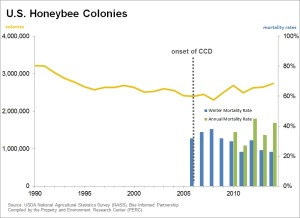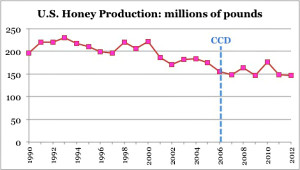Jul
26
To Bee Worried, or Not to Bee Worried
“By engaging in simplistic and sometimes misleading environmental narratives — by exaggerating the stakes and brushing over the inconvenient facts that stand in the way of foregone conclusions — we do our field, and our subjects, a disservice.” — Hannah Nordhaus, environmental journalist and author of The Beekeeper’s Lament
No one likes to get stung, so we tend to fear, or at least shy away from, bees. But, we also need to remember that, in many ways, bees are our friends. After all, they don’t just pollinate 16% of all the flowering plant species. They also pollinate one-third of our food crops, which not only keeps us well-fed but adds $14-15 billion dollars annually to the U.S. agricultural industry alone. As such, they are an integral part of the food chain, as well as a source of jobs and wealth-building. So, we would have a right to be concerned if something began causing bees to die off.
 Back in 2006, some commercial beekeepers started seeing higher-than-normal winter die-offs among honeybees — more than double the usual 15% average. As more reports came out and the media ran with it, we have seen alarmist claims of “a crisis point for crops,” a “threat to our food supply,” and my fellow word-players have warned us of “beemageddon” and the “beepocalypse”. (Heck, I even saw an episode of “Elementary” last season that dealt with it.) It isn’t only honeybees that are affected, either. Bumblebees, which make similar contributions, have seen population declines, too. The overall phenomenon has been dubbed Colony Collapse Disorder (CCD), and the various culprits accused of causing it range from parasites (e.g., Varroa mites), neonicotinoid insecticides, and GMOs, to coldspells from anthropogenic climate change, even cell phones.
Back in 2006, some commercial beekeepers started seeing higher-than-normal winter die-offs among honeybees — more than double the usual 15% average. As more reports came out and the media ran with it, we have seen alarmist claims of “a crisis point for crops,” a “threat to our food supply,” and my fellow word-players have warned us of “beemageddon” and the “beepocalypse”. (Heck, I even saw an episode of “Elementary” last season that dealt with it.) It isn’t only honeybees that are affected, either. Bumblebees, which make similar contributions, have seen population declines, too. The overall phenomenon has been dubbed Colony Collapse Disorder (CCD), and the various culprits accused of causing it range from parasites (e.g., Varroa mites), neonicotinoid insecticides, and GMOs, to coldspells from anthropogenic climate change, even cell phones.
Enter, the U.S. Federal Government to the rescue…
In 2014, the Obama administration issued a presidential memo directing the formation of a task-force to develop “a Federal Strategy to Promote the Health of Honey Bees and Other Pollinators.” Last month, the Pollinator Health Task Force, co-chaired by the Secretary of Agriculture and the Administrator of the Environmental Protection Agency and including the heads of multiple other Executive departments and agencies, announced its creatively-named “National Strategy to Promote the Health of Honey Bees and Other Pollinators”. The plan? Reduce the honeybee-colony losses to “sustainable” levels and create 7 million acres of pollinator-friendly habitat, all for the low, low price of $82 million. (I wonder how long before that estimate gets adjusted upward.)
A noble goal, and perhaps even a reasonable price — that is, assuming the problem is real and as bad as we are led to believe. Consider this, as reported by Shawn Regan at the Property and Environment Research Center (PERC):
o There are more honeybee colonies in the U.S. today than there were when colony collapse disorder began in 2006.
o According to the USDA, U.S. honeybee-colony numbers are now at a 20-year high.
o U.S. honey production is also at a 10-year high.
Regan continues…
“Almost no one has reported this, but it’s true. You can browse the USDA reports yourself. [Note: See the graphs in this post.] Since colony collapse disorder began in 2006, there has been virtually no detectable effect on the total number of honeybee colonies in the United States. Nor has there been any significant impact on food prices or production.
How can this be? In short, commercial beekeepers have adapted to higher winter honeybee losses by actively rebuilding their colonies. This is often done by splitting healthy colonies into multiple hives and purchasing new queen bees to rebuild the lost hives. Beekeepers purchase queen bees through the mail from commercial breeders for as little as $15 to $25 and can produce new broods rather quickly. Other approaches include buying packaged bees (about $55 for 12,000 worker bees and a fertilized queen) or replacing the queen to improve the health of the hive. By doing so, beekeepers are maintaining healthy and productive colonies — all part of a robust and extensive market for pollination services.”
While this need to replenish their increased losses means that commercial beekeepers are obliged to buy more queens & workers, the abovementioned ease and speed with which large numbers of queens can be raised has kept commercial breeders from needing to raise their already low prices. Now, it is true that the pollination fees beekeepers charge producers of almonds — a very important pollination crop — have more than doubled in recent years. But, the rise began a few years before CCD was reported, so CCD can only account for a portion of the inflation. The almond producers have had to pass on much of their increased costs to the consumer, so you might have to pay an additional 3 cents or less for a pound of Smokehouse Almonds. (Not exactly a budget-breaker.) The increased fee income has helped many beekeepers more than recover the costs of rebuilding their lost colonies.
To summarize, then, commercial bee colonies are stable and healthy, honey production is up, and economists Randal Rucker and Walter Thurman’s research on the relevant markets led them to conclude that CCD has had almost no discernible economic impact. It seems that commercial beekeepers are not the “passive, unimaginative onlookers” to disaster that some journalists make them out to be. They actually know what they’re doing, and they have responded & adapted to this problem as they have to others. Also, while the CCD phenomenon is worthy of concern and research, the supposedly impending bee/food crisis is hardly the calamity that some, including the Obama administration, are making it out to be. In fact, as Regan has observed,
“With U.S. honeybee colonies now at a 20-year high, you have to wonder: Is our national pollination strategy a solution in search of a crisis?”
So much for the “beepocalypse”….
















